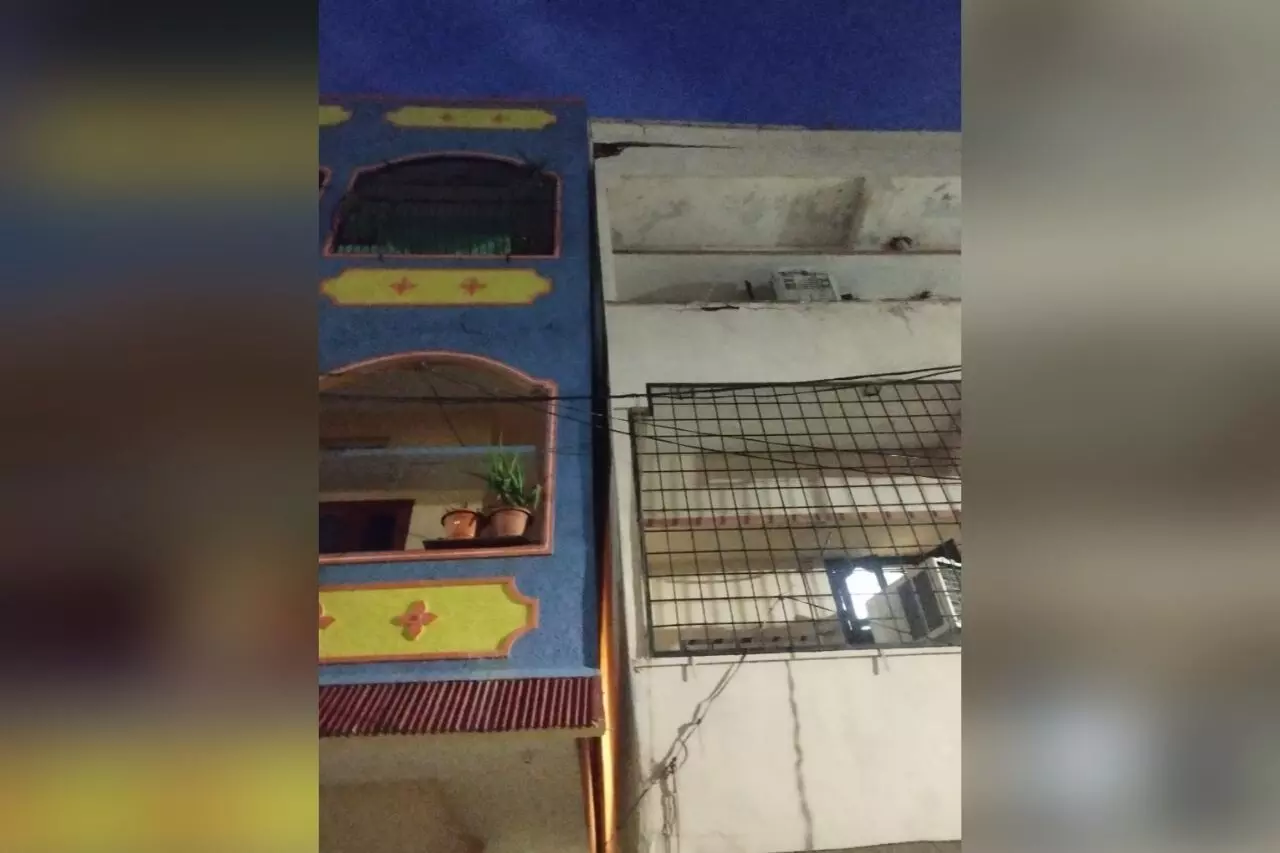Monsoon woes: Quthbullapur man tilts building in bid to raise house, GHMC orders demolition
The engineers, who haven’t had much experience in engineering the lifting operation, failed. The ground floor of the building is damaged and the building leaned over the adjacent building
By Sri Lakshmi Muttevi
Hyderabad: In a situation with unintended consequences, a building owner in Chintal, Quthbullapur area, in Medak district who tried to lift his G+2 house using hydraulic jacks, failed, resulting in total damage to the apartment. His attempt to raise the building damaged the ground floor of the apartment and the building leaned onto the adjacent building.
GHMC has passed orders to demolish the building. Currently, the DRF teams are shifting household items of the residents. The demolishing works which are to start on Sunday got postponed due to rain.
This incident happened in Srinivasanagar, Jeedimetla on Saturday night. Upon receiving information from the locals, the Greater Hyderabad Municipal Corporation (GHMC) inspected the building.
According to local testimonies, the house owner, Nageshwara Rao, had built the house in Srinivasanagar around 25 years ago. The owner consulted a house lifting company based in Vijayawada to lift his building to avoid rainwater entering his house in the coming rainy season.
As the road levels rose over the years, rainwater started entering his building’s ground floor. In 2022 monsoons, Quthbullapur is one of the two localities which saw the highest rainfall and water flooding. Many residents saw buildings being inundated with drain water from the nearby nala. However, Narasimha Rao did not take any permission from the GHMC town planning department to pursue his renovation.
A total of six families including the owner are living in the building. As the lifting operations began, four families vacated the building while the owner and another family stayed in the same building.
“The engineers, who haven’t had much experience in engineering the lifting operation, failed. The ground floor of the building is damaged and the building leaned over the adjacent building. We immediately cleared the residents living inside the apartment,” said Sambaiah, assistant commissioner, Town Planning in Quthbullapur, GHMC.
“Both buildings are old and are not strong enough to conduct lifting operations using hydraulic jacks. This resulted in the failure of the operations,” said the town planning official.
A case has been registered on Nageshwara Rao for not taking official permission.
On Sunday morning, Quthbullapur MLA Vivekananda visited the area and assured the locals that they would take necessary precautions for demolishing the building. “No technical expert consultation was taken up by the owner, which is a mistake. The area was agricultural land, which had loose soil. The house lifting company did not study the area before starting work,” said the MLA.
“A JNTU-led expert team will visit the area and would examine the situation and give us suggestions,” the MLA added.
Plans to demolish the building
Sambaiah, Quthbullapur Assistant commissioner, Town Planning, who inspected the area, said they have decided to demolish the house after taking expert opinion. “We vacated the locals in the surrounding areas, and are investigating on how to proceed further,” he said.
How are houses lifted?
House lifting, also called house jacking, is the process of separating a building from its foundation and raising it with hydraulic screw jacks. The flooring of the ground floor is first removed, and a trench is dug along the walls. The jacks are placed and the building is slowly raised. Once a house is raised and supported on cribbing, a new foundation can be constructed beneath it. It takes approximately 30-45 days to lift a 1,200 sq ft house by three feet.
A risky affair
It is a risky affair and the owner should ensure the building remains strong during the work and take prior permissions. It is also expensive, costing around Rs 4-5 lakhs depending on the building.
This practice is prominently seen in cities prone to flooding during rains. It is expensive, but residents who face extreme flooding during the monsoons find lifting to be a better alternative to demolishing and building a new house. In India, cities such as Pune, Bengaluru and Visakhapatnam have seen such house-lifting operations.
House lifting is practised in countries such as New York and New Jersey where people raised houses in the aftermath of Hurricane Katrina and Hurricane Sandy. In the United States, agencies like the Federal Emergency Management Agency (FEMA) advise raising houses in susceptible areas to a desired Flood Protection Elevation (FPE). They also determine to which point the owners should elevate their homes by calculating the base flood elevation (BFE) — the baseline where a flood would hit during a superstorm.
Previous cases
In 2022, a house owner in Mancherial lifted his house by 6 feet. His G+1 house was constructed in 2013. The ground floor gradually went down due to road construction. He opted for house lifting and was successful.
In 2022, a house owner took up house lifting, after many houses in the city flooded with water on the ground floor. The resident Sowmya, after extensive floods in Bengaluru, opted for house lifting, as she felt it was a cheaper option than building a house.
In 2015, a house in MVP colony in Visakhapatnam, Andhra Pradesh, tried a similar operation of lifting the house by six feet using jacks. He was successful and made house lifting quite popular.